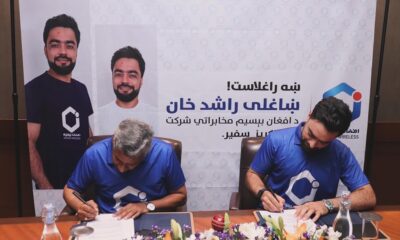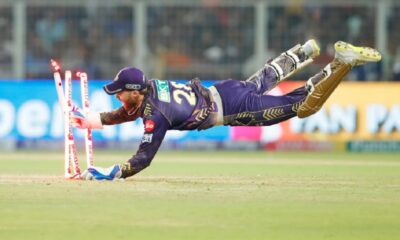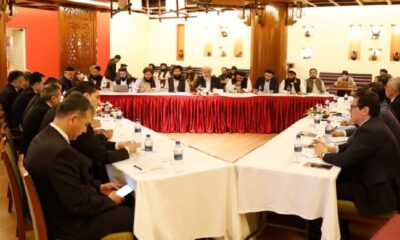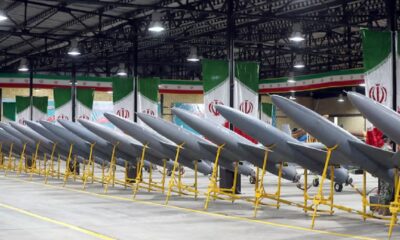Science & Technology
Study documents headaches experienced by astronauts in space

Research in the expanding field of space medicine has identified many ways in which a microgravity environment and other factors can meddle with the human body during space missions. A new study has added to the field by showing that astronauts are more likely to experience headaches in space than previously known.
The study involved 24 astronauts from the U.S., European and Japanese space agencies who traveled aboard the International Space Station for up to 26 weeks. All but two of them reported experiencing headaches in space.
This was a larger proportion than the researchers had expected based on prior anecdotal evidence. The headaches – some resembling migraines and others resembling tension headaches – occurred not only during the first couple of weeks in space as the body goes through the process of adapting to microgravity, but also later.
The headaches occurring during the early period often present as migraine-like while those experienced later in space travel present more like a tension headache, the study found.
“We hypothesize that different mechanisms are involved for the early headache episodes – the first one to two weeks in space – versus later headache episodes,” said neurologist WPJ van Oosterhout of Zaans Medical Center and the Leiden University Medical Center in the Netherlands, lead author of the study published this week in the journal Neurology, opens new tab.
“In the first week, the body has to adapt to the lack of gravity, known as space adaptation syndrome. This phenomenon is similar to motion sickness, and can cause nausea, vomiting and dizziness, and headaches,” Van Oosterhout said. “The later headaches could result from an increase in intracranial pressure. Due to microgravity, there is more fluid accumulating in the upper part of the body and head, resulting in higher pressure in the skull.”
Migraines experienced on Earth are often throbbing and pulsating headaches lasting four to seven hours, accompanied by symptoms such as nausea, vomiting and hypersensitivity to light and sound, Van Oosterhout said. Tension-type headaches on Earth usually are a more dull pain felt over the entire head without those other symptoms, Van Oosterhout added.
The astronauts – 23 men and one woman, with an average age of about 47 – were aboard the International Space Station for missions that took place from November 2011 to June 2018, with a total of 378 headaches reported by 22 of the 24 astronauts during a total of 3,596 days in orbit. None of the 24 reported headaches in the three months after returning to Earth.
Thirteen of the astronauts were from NASA, six from the European Space Agency, two from Japan’s JAXA and one from the Canadian Space Agency. None had ever been diagnosed with migraines prior to their space missions and none had a history of recurrent headaches.
Various documented effects of space travel include bone and muscle atrophy, changes in the brain, cardiovascular system and immune system, issues with the balance system in the inner ear and a syndrome involving the eyes. Cancer risk from greater radiation exposure in space is another concern.
Experts are unsure of how much of a barrier these effects might be on human space travel over extended periods, for instance for journeys to our neighboring planet Mars or beyond.
“The honest answer is that we don’t know the effects of long-duration space travel – possibly years – on the human body,” Van Oosterhout said. “It is clear that even short-term – days or weeks – to medium-term – weeks or months – duration exposure to microgravity already has some effects, mostly reversible, on the human body. This is a clear task for the field of space medicine.” – Reuters
Science & Technology
Apple loses top phonemaker spot to Samsung as iPhone shipments drop, IDC says

Apple’s (AAPL.O), opens new tab smartphone shipments dropped about 10% in the first quarter of 2024, hurt by intensifying competition by Android smartphone makers aiming for the top spot, data from research firm IDC showed on Sunday.
Global smartphone shipments increased 7.8% to 289.4 million units during January-March, with Samsung (005930.KS), opens new tab, at 20.8% market share, clinching the top phonemaker spot from Apple, Reuters reported.
The iPhone-maker’s steep sales decline comes after its strong performance in the December quarter when it overtook Samsung as the world’s No.1 phone maker. It’s back to the second spot, with 17.3% market share, as Chinese brands such as Huawei gain market share.
Xiaomi, one of China’s top smartphone makers, occupied the third position with a market share of 14.1% during the first quarter, read the report.
South Korea’s Samsung, which launched its latest flagship smartphone lineup – Galaxy S24 series – in the beginning of the year, shipped more than 60 million phones during the period.
Global sales of Galaxy S24 smartphones jumped 8%, compared to last year’s Galaxy S23 series during their first three weeks of availability, data provider Counterpoint previously said.
In the first quarter, Apple shipped 50.1 million iPhones, down from 55.4 million units it shipped same period last year, according to IDC.
Apple’s smartphone shipments in China shrank 2.1% in the final quarter of 2023 from a year earlier.
The drop underscores the challenges facing the U.S. firm in its third biggest market, as some Chinese companies and government agencies limit employees’ use of Apple devices, a measure that mirrors U.S. government restrictions on Chinese apps on security grounds.
The Cupertino, California-based company in June will hold its Worldwide Developers Conference (WWDC), where it will highlight updates to the software powering iPhones, iPads, and other Apple devices.
Investors are closely watching for updates on artificial intelligence development at Apple, which has so far spoken little about incorporating the AI technology into its devices. The company earlier this year lost the crown as the world’s most valuable company to Microsoft (MSFT.O), opens new tab, Reuters reported.
Science & Technology
China launch of relay satellite Queqiao-2 for lunar probe mission successful

China National Space Administration (CNSA) said on Friday its launch of a key signal relay satellite was a “complete success” and it would serve as the communication bridge for its future lunar probe missions for years to come, state media reported.
China launched the satellite Queqiao-2, which was named after a mythological bridge made of magpies, and two miniature satellites, Tiandu-1 and Tiandu-2, on March 20.
Queqiao-2 will be used as a communications bridge between the ground operations on earth and upcoming lunar probe missions on the far side of the moon until at least 2030.
The moon’s near side always faces earth. That means data transfers from the far side are impossible because there is no direct line of sight.
Queqiao-2 researcher and developer Xiong Liang described the satellite as “the main switch” of the whole fourth phase of lunar missions, according to state television CCTV.
“Only when the main switch is flipped on, all the communications can kick off,” Xiong said.
Queqiao-2 will orbit the moon and relay signals to and from the Chang’e-6 mission, which expected to be launched in May. The robotic Chang’e-6 probe will seek to retrieve samples from an ancient basin, acquiring lunar material from the moon’s hidden side for the first time.
Queqiao-2 will also be used as a relay platform for the Chang’e-7 lunar mission in 2026 and the Chang’e-8 mission in 2028.
The functions and performance of Queqiao-2 met mission requirements and it will be able to provide relay communication services for China’s lunar exploration projects and future lunar missions for China and other countries, said the CNSA, according to CCTV.
Queqiao-2 entered its targeted elliptical orbit on April 2 after a correction midway, near-moon braking and orbital manoeuvre around the moon, CNSA said.
The satellite has successfully communicated with Chang’e 4, which was the first spacecraft to perform a soft landing on the far side of the moon and is still carrying out its exploration mission. It also communicated with the Chang’e-6 probe while it is still on the ground earlier this month.
The successful launch of Queqiao-2 comes after the failed launch of another lunar spacecraft DRO-A/B satellites, which was intended to enter the moon’s distant retrograde orbit (DRO).
China has not released any information on whether or not the satellites can be retrieved.
(Reuters)
Science & Technology
Russia aborts planned test launch of new heavy-lift space rocket

Russian space officials on Tuesday aborted the test launch of a new heavy-lift rocket from its far-eastern launch pad.
The Angara-A5 rocket was scheduled to lift off from the Vostochny space launch facility at 0900 GMT Tuesday, but the launch was aborted two minutes before, AP reported.
Yuri Borisov, head of Roscosmos state space corporation, said the automatic safety system canceled the launch after registering a flaw in the oxidizer tank pressurization system.
He said the next launch attempt was set for Wednesday.
Tuesday’s launch was to be the fourth for the Angara-A5, a heavy-lift version of the new Angara family of rockets that has been developed to replace the Soviet-designed Proton rockets.
-

 Latest News3 days ago
Latest News3 days agoRashid Khan named AWCC’s brand ambassador
-

 Regional4 days ago
Regional4 days agoIranian president lands in Pakistan for three-day visit to mend ties
-

 Sport4 days ago
Sport4 days agoKolkata beat Bengaluru by one run in IPL as Kohli fumes at dismissal
-

 Sport4 days ago
Sport4 days agoACL: Aino Mina 3-0 Istiqlal Kabul; Attack Energy 3-0 Khadim
-

 Climate Change4 days ago
Climate Change4 days agoRescuers race to reach those trapped by floods in China’s Guangdong
-

 Business5 days ago
Business5 days agoAfghanistan, Kazakhstan to hold joint expo in Kabul
-

 World3 days ago
World3 days agoMalaysian navy helicopters collide in mid-air, 10 killed
-

 Sport3 days ago
Sport3 days agoJaiswal ton powers Rajasthan to big IPL win
























